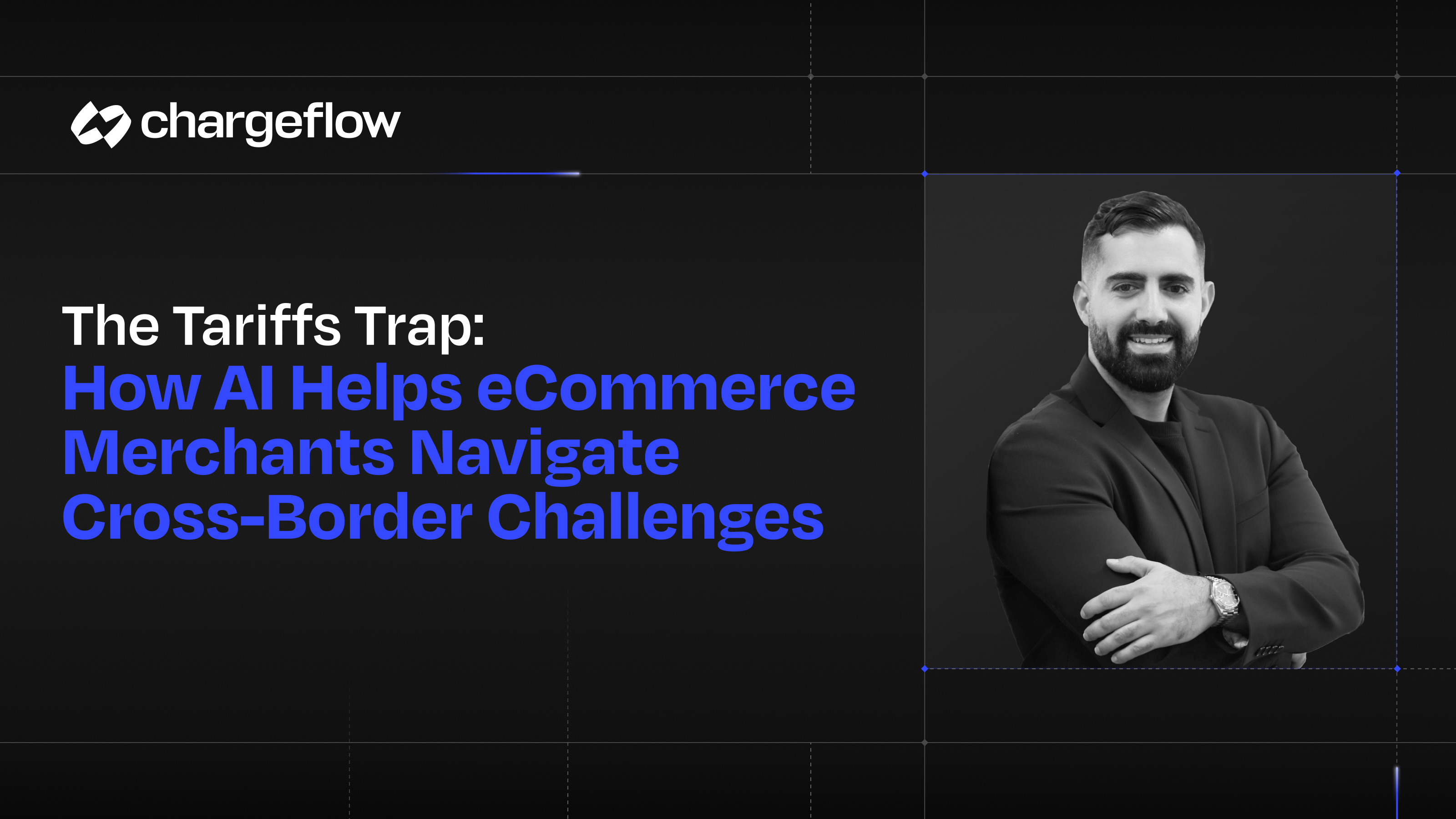Transaction Laundering: Slightly Unknown Scam that Plunges Ecom Store Owners' Revenue

Chargebacks?
No longer your problem.
Recover 4x more chargebacks and prevent up to 90% of incoming ones, powered by AI and a global network of 15,000 merchants.
Unmask the slightly unknown scam of transaction laundering that drains e-commerce store owners revenue. Shield your business with our proactive solution
Welcome, fellow e-commerce merchant! In the vast digital landscape of online businesses, we constantly strive for success, growth, and, of course, revenue. But what if I told you there's a lurking danger, a cunning scam that silently drains your hard-earned profits?
Chargeflow will shed light on a slightly unknown yet devastating threat to e-commerce store owners like yourself: transaction laundering.
In this article, we delve deep into the treacherous world of transaction laundering, uncovering its devious mechanisms and exploring its detrimental consequences. Prepare yourself for an eye-opening journey that will empower you with the knowledge and tools to safeguard your revenue, protect your reputation, and ensure the longevity of your e-commerce business.
Now, you might be wondering, what exactly is transaction laundering? How does it affect me as a merchant? And most importantly, how can I detect and prevent it? Fear not, dear reader, for we shall address these pressing questions and more.
So, tighten your seatbelt, keep your eyes peeled, and embark on this educational voyage with us.
Together, we will unveil the sinister world of transaction laundering, equip you with the tools of detection and prevention, and empower you to protect your e-commerce empire. It's time to reclaim your revenue and secure the future of your online business. Let's dive in!
Understanding E-commerce Revenue Generation
In this dynamic and competitive landscape, it's crucial to have a clear understanding of the key sources that drive revenue for your e-commerce store. Let's delve into the world of e-commerce revenue generation and discover the strategies that can keep your revenue flowing.
First and foremost, your e-commerce store's revenue stems from customer purchases. These purchases can be categorized into two main types: direct sales and indirect sales. Direct sales refer to transactions where customers buy products directly from your online store.
On the other hand, indirect sales occur when customers make purchases through other channels, such as affiliate websites or social media platforms.
To maximize revenue, you need to optimize each stage of the customer journey. It starts with attracting potential customers to your online store through effective marketing techniques.
Utilize search engine optimization (SEO) strategies to improve your store's visibility in search results and drive organic traffic. Leverage social media platforms and influencer partnerships to engage with your target audience and entice them to visit your store.
Once customers land on your e-commerce website, it's essential to provide a seamless user experience that encourages conversions. Optimize your website's design, navigation, and product presentation to ensure a user-friendly interface.
Streamline the checkout process by offering various payment options, providing transparent pricing, and implementing trust-building measures like secure sockets layer (SSL) certificates.
What is Transaction Laundering?
Lurking in the shadows is a deceptive scam that can drain your hard-earned profits without you even realizing it: transaction laundering.
Picture this: You've worked tirelessly to establish your e-commerce store, attract customers, and generate revenue. But behind the scenes, transaction laundering is quietly siphoning off your earnings, leaving you with a fraction of what you rightfully deserve. It's time to uncover this stealthy scam and arm yourself with the knowledge to protect your business.
Transaction laundering is an intricate scheme used by fraudsters to exploit the payment processing system, bypassing security measures and funneling illicit transactions through seemingly legitimate channels.
These fraudsters employ various techniques, such as credit card transactions, digital currencies, and third-party payment platforms, to disguise the true nature of their activities.
So, how does transaction laundering work? Let's dive into the mechanics. Fraudsters create a web of interconnected transactions, making it challenging to trace the origin and destination of the funds involved.
They cleverly exploit the complexities of the e-commerce ecosystem, using multiple layers of transactions to conceal their fraudulent activities.
As a merchant, it's crucial to understand the impact of transaction laundering on your business. Beyond the financial losses, which can be significant, this scam tarnishes your reputation and erodes customer trust.
Imagine the dismay of your loyal customers when they discover that their hard-earned money might be indirectly supporting illegal activities.
The Impact of Transaction Laundering on E-commerce Store Owners
As an E-commerce store owner, you work tirelessly to generate revenue and build a thriving business. However, there is a stealthy scam lurking in the shadows that can drain your hard-earned revenue and jeopardize your entire operation: transaction laundering.
The impact of transaction laundering on E-commerce store owners is significant and far-reaching. Let's explore the detrimental effects this deceptive practice can have on your business:
Revenue Losses and Financial Implications
- Transaction laundering siphons off your revenue, leading to substantial financial losses.
- Hidden transactions and fraudulent activities can go undetected, resulting in a significant dent in your profits.
- The financial implications may extend to chargebacks, fines, penalties, and increased transaction processing costs.
Damaging Effects on Reputation and Customer Trust
- Transaction laundering undermines the integrity of your business, tarnishing your reputation among customers, partners, and industry peers.
- When customers discover fraudulent activities associated with your store, trust is shattered, leading to a loss of loyal customers and reduced sales.
- Negative publicity and customer backlash can have long-lasting repercussions on your brand's image and customer perception.
Legal Consequences and Regulatory Compliance
- Engaging in transaction laundering puts your E-commerce store at risk of legal repercussions.
- Authorities and regulatory bodies impose strict regulations to combat money laundering and fraudulent transactions.
- Non-compliance with these regulations can result in hefty fines, legal battles, and a potential shutdown of your business.
Identifying Transaction Laundering Red Flags
As an e-commerce store owner, it is crucial to be vigilant and proactive in detecting transaction laundering, a stealthy scam that can drain your revenue. By understanding the red flags associated with this illicit activity, you can protect your business and ensure the integrity of your financial transactions.
Here are some key indicators to watch out for:
1. Unusually Large Transactions
Keep an eye on transactions that are significantly larger than your average order value. High-value transactions can be a red flag for potential money laundering attempts.
2. Frequent Split Payments
Take note of customers who repeatedly split their payments into multiple smaller transactions. This tactic is often used to avoid detection and bypass transaction limits.
3. Inconsistent Billing and Shipping Information
Be wary of orders where the billing and shipping information do not match, or if the information provided seems suspicious or inconsistent. This misalignment may indicate fraudulent activity.
4. Rapid Changes in Transaction Patterns
Monitor any sudden and significant shifts in your customers' transaction behavior. Abrupt changes in purchasing habits or unusual spikes in transaction frequency could indicate attempts to launder money.
5. Unusual IP Addresses or Geographical Discrepancies
Take notice of orders originating from IP addresses or locations that are inconsistent with your typical customer base. Transactions coming from high-risk regions or unexpected locations can raise red flags.
6. Large Number of Declined Transactions
Keep track of a disproportionately high number of declined transactions from a particular customer or IP address. This could be a sign of multiple attempts to process fraudulent transactions.
7. Multiple Orders with Different Names but Same Payment Details
Pay attention to orders placed using different customer names but the same payment information. Criminals often use stolen credit cards or compromised accounts to place such orders.
8. Unusual Transaction Timing
Be cautious of transactions that occur during non-business hours or in rapid succession. These irregularities in timing can be an indication of suspicious activity.
9. Abnormal Purchase Patterns
Watch out for customers making repetitive purchases of the same high-value item or ordering an unusually large quantity of products. Such abnormal purchase patterns may be a signal of money laundering.
10. Fluctuating Shipping Addresses
Take notice of customers who frequently change their shipping addresses, particularly if they frequently use different addresses for similar orders. This behavior could be an attempt to obscure the origin of illicit funds.
Preventing and Combating Transaction Laundering
Transaction laundering, a stealthy scam that drains your hard-earned profits, requires your attention and proactive measures. By understanding the risks and implementing effective strategies, you can protect your business and ensure a secure financial environment.
Here are some key steps you can take to prevent and combat transaction laundering:
1. Educate Your Staff on Transaction Laundering Risks
- Provide comprehensive training: Ensure that all employees involved in payment processing are aware of the signs and risks associated with transaction laundering. Train them to identify suspicious activities and report them promptly.
- Stay updated on emerging trends: Keep your staff informed about the latest techniques used by fraudsters. Regularly share information and resources to enhance their knowledge and vigilance.
2. Conduct Regular Security Audits and Risk Assessments
- Assess vulnerabilities in your systems: Regularly evaluate your payment infrastructure, website security, and data handling processes. Identify potential weak points and take appropriate measures to strengthen them.
- Employ third-party audits: Engage reputable cybersecurity firms to conduct comprehensive audits of your systems. Their expertise can help uncover any vulnerabilities that may be exploited by criminals.
3. Partner with Trustworthy Payment Service Providers
- Choose reliable partners: Select payment service providers with a strong track record in fraud prevention and security. Look for those that employ robust verification and authentication measures to minimize the risk of transaction laundering.
- Leverage advanced risk management tools: Ensure your payment service provider offers cutting-edge fraud detection and prevention solutions. Look for features such as real-time transaction monitoring, anomaly detection, and machine learning algorithms that adapt to evolving threats.
4. Implement Effective Verification and Authentication Measures
- Use multi-factor authentication: Require customers to provide multiple forms of verification, such as passwords, one-time codes, or biometric data, to complete transactions. This helps ensure that only legitimate customers can access and use payment services.
- Employ address verification systems: Utilize address verification tools to match billing addresses with the records of credit card issuers. This helps detect discrepancies that may indicate fraudulent activity.
5. Collaborate with Law Enforcement and Regulatory Agencies
- Report suspicious activities: If you encounter any transactions or patterns that raise suspicions, promptly report them to the appropriate law enforcement agencies and regulatory bodies. Cooperating with authorities is crucial for combating transaction laundering effectively.
- Stay informed about legal obligations: Stay updated on relevant laws and regulations pertaining to e-commerce and financial transactions. Adhere to compliance requirements, including anti-money laundering (AML) and know-your-customer (KYC) regulations.
The Role of Technology in Detecting Transaction Laundering
By harnessing the power of technology, you can safeguard your business from this insidious threat.
Advanced Machine Learning and AI Solutions
- Machine learning algorithms equipped with artificial intelligence are revolutionizing fraud detection in e-commerce.
- These advanced systems analyze vast amounts of transaction data, identifying patterns and anomalies that indicate potential laundering activities.
- By leveraging AI, these solutions continuously learn and adapt to evolving laundering techniques, providing real-time protection.
Blockchain Technology for Transparent Transactions
- Blockchain, the technology behind cryptocurrencies like Bitcoin, offers transparent and immutable transaction records.
- Implementing blockchain-based systems in your e-commerce operations adds an additional layer of security and accountability.
- With blockchain, every transaction becomes traceable, making it harder for launderers to disguise their illicit activities.
Innovations in Fraud Prevention Systems
- Stay ahead of sophisticated launderers by employing cutting-edge fraud prevention systems.
- These systems leverage advanced algorithms, behavioral analytics, and real-time monitoring to identify suspicious transactions.
- By integrating these innovations into your payment processing infrastructure, you can automatically flag and investigate potentially fraudulent activities.
Benefits of Technological Solutions
- Efficient Detection: Technology-driven solutions can quickly identify and flag suspicious transactions, minimizing the risk of revenue loss.
- Real-time Protection: With advanced systems continuously monitoring transactions, you receive immediate alerts regarding potential laundering attempts.
- Scalability: Technology allows you to scale your fraud detection efforts effortlessly, accommodating the growth of your e-commerce business.
Collaboration with Technology Providers
- Partnering with trustworthy technology providers ensures access to the latest advancements in transaction laundering detection.
- These providers offer specialized tools and expertise to help you implement and optimize fraud prevention systems tailored to your unique business needs.
- By collaborating with technology experts, you can focus on running your e-commerce store while relying on their specialized knowledge to combat laundering attempts.
Strategies for E-commerce Store Owners to Safeguard Revenue
Here are some key strategies to consider:
1. Stay Educated and Vigilant
- Continuously educate yourself and your staff about the risks and signs of transaction laundering.
- Stay updated on the latest fraud trends and emerging techniques used by scammers.
- Regularly review industry resources, attend webinars, and participate in relevant forums to stay informed.
2. Implement Robust Fraud Detection Systems
- Invest in advanced fraud detection tools and technologies that can identify suspicious transactions in real time.
- Leverage machine learning and AI algorithms to analyze patterns and detect anomalies.
- Set up automated alerts for potentially fraudulent activities to take immediate action.
3. Establish Strong Verification and Authentication Measures
- Implement a multi-layered verification process for high-risk transactions, such as large orders or international purchases.
- Use reliable identity verification solutions to confirm the authenticity of customer information.
- Employ secure authentication methods, such as two-factor authentication, to enhance security.
4. Foster Collaboration with Payment Service Providers
- Partner with reputable payment service providers that prioritize security and have robust fraud prevention measures in place.
- Regularly communicate with your payment service provider to address any concerns or potential issues promptly.
- Utilize their expertise and resources to stay updated on the latest fraud prevention strategies.
5. Conduct Regular Security Audits and Risk Assessments
- Perform periodic security audits to identify vulnerabilities in your system and plug any loopholes.
- Conduct thorough risk assessments to evaluate potential areas of weakness in your revenue protection processes.
- Implement necessary security patches and updates to keep your e-commerce platform secure.
6. Monitor and Analyze Transaction Data
- Use analytics tools to monitor transaction data and identify patterns or anomalies.
- Look for discrepancies, such as unusually high refund rates or frequent chargebacks, that may indicate fraudulent activities.
- Regularly review and analyze your financial reports to spot any irregularities.
7. Foster a Culture of Security Awareness
- Train your staff on best practices for security and fraud prevention.
- Promote a culture of security awareness by emphasizing the importance of vigilance and reporting any suspicious activities.
- Encourage open communication among your team members to address security concerns promptly.
Final Thoughts
Transaction laundering poses a hidden danger to e-commerce store owners, quietly draining their revenue and tarnishing their reputation. To combat this threat, merchants must remain vigilant and proactive.
By understanding the red flags, collaborating with payment service providers, and leveraging advanced technologies, they can protect their hard-earned profits. Stay informed, fortify your defenses, and together we can expose transaction laundering and safeguard the future of online businesses.

Chargebacks?
No longer your problem.
Recover 4x more chargebacks and prevent up to 90% of incoming ones, powered by AI and a global network of 15,000 merchants.






























.png)








